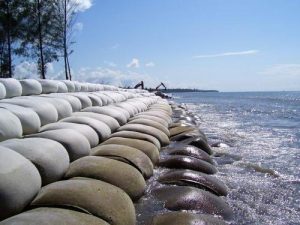Role of Geobags and Gabions in Flood Protection
Floods, a natural calamity, can happen in just a moment. In minutes, a once picturesque landscape with a meandering stream or calm river can transform into a raging deluge, powerful enough to cause widespread devastation. They leave behind a trail of destruction with loss of life, personal property, and public infrastructure. What once was a rare phenomenon is now becoming an annual occurrence world over, thanks to severe climatic changes.
Currently, about 40% of the world’s population lives within 100 km of the coastline. As per a 2019 study, the sea level will rise by 30 cm in 2050 and approximately 69 cm by 2100. These are, of course, approximate conservative measures.
Table of Contents
The world we live in today faces many serious threats, of which climate change and its detrimental impacts are things we cannot ignore. A rise in sea level is a known consequence of climate change. There can be massive environmental and socio-economic impacts due to flooding. Safeguarding people, property, and other valuable structures as the sea level continue to rise is an engineering challenge of gigantic proportions for the 21st century and beyond.
It is essential to find environmental engineering solutions to mitigate the impact of rising sea levels and storm impact on shorelines. Geosynthetics have come to be an indispensable part of environmental engineering for decades now. Depending on site-specific situations, geosynthetics offer cost-effective and longer-lasting solutions to various construction and engineering purposes. The Geobags and Gabions, in particular, come to the rescue with their applications in flood abatement, eliminating flooding of coastal regions.
Use of Geobags and Gabions in Flood Protection:
Geosynthetics provide an array of flood defense solutions, whether to halt erosion, reinforce coastlines and riverbanks, or prevent floods. Geobags also referred to as the Geotextile Sand Containers, are robust containers primarily deployed for riverbanks and shoreline protection.
The Geobags are perhaps the most viable and practical solutions for riverbank protection. Made of either heavy-duty woven or nonwoven geotextiles like polypropylene, polyester, or polyethylene, the Geobags placed within steel Gabions or PP rope Gabions and placed at regular intervals impart stability to scour protection.
The versatile and highly robust Geobags are filled with sand either on-site or near-site and stacked one upon the other, finding applications in coastal protection, dams, levees, or inland waterways. They are sewn to withstand rough handling, and the fabric ensures soil retention under abrasive and hydraulic stresses.
However, Gabions are more suitable in situations where the height is more. Gabions can be deployed as a retaining wall as a temporary flood protection structure. The Gabion retaining walls provide containment, confinement, and protection applications and are a cost-effective alternative to traditional methods.
The Gabion baskets or wire mesh containers stacked together with locally filled material provide a stable structure for flood-prone waterways. The highly galvanized metal mesh is corrosion resistant providing a longer design life. Gabion flood barriers have welded wire mesh panels joined and reinforced with spiral joints giving them higher strength to withstand the powerful impact of water currents and other debris.
In Conclusion
From the standpoint of structural stability, flexibility, economic serviceability, and even aesthetics, the Gabions and Geobags are ideal geosynthetic solutions for flood protection. They are not just economical, easy to assemble on-site, need little or no maintenance, and customizable, but also rugged and highly durable, resistant to environmental stresses. As an added benefit, they are ecologically safe, reducing the carbon footprint.
Whether you need versatile Gabions or Geobags, Ocean Geosynthetics has the experience and expertise to help you.
Connect with our experts to discuss your environmental engineering needs.
FAQs
Can gabion boxes be customized in terms of size and shape?
Yes, gabion boxes can be customized to suit specific project requirements, allowing for various sizes, shapes, and even curvatures.
Do gabion boxes require maintenance?
Gabion boxes are generally low maintenance. However, occasional inspections and removal of debris or sediment buildup may be necessary.
Are there any design considerations for using gabion boxes?
Yes, when using gabion boxes, it’s essential to consider factors such as soil conditions, drainage requirements, and the need for proper anchoring and geotextile installation.



